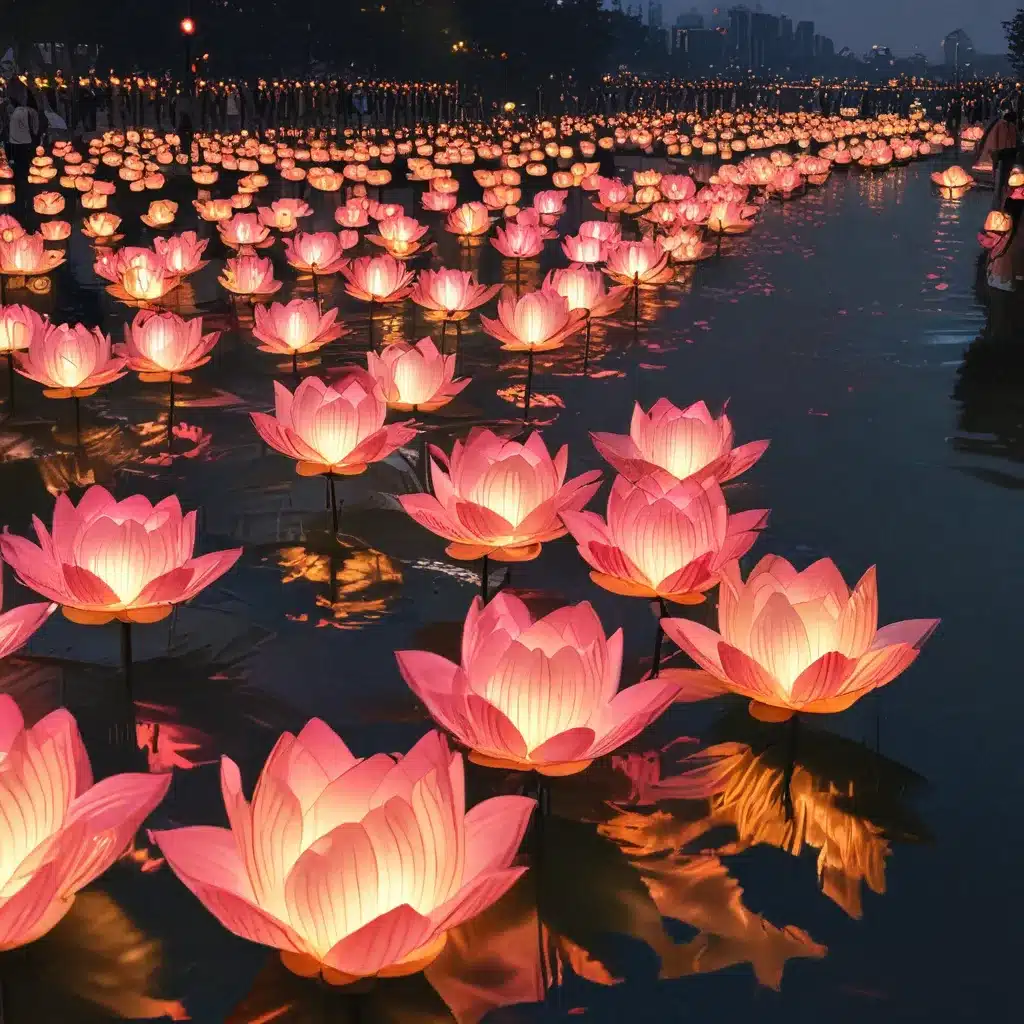
Floating in a Sea of Lights
It’s a balmy spring evening in Seoul, and I find myself amidst a dazzling display of color and illumination at the Yeouido Floating Island. Thousands of vibrant lotus-shaped lanterns sway gently in the breeze, their soft glow reflecting off the tranquil waters of the Han River. The air is filled with the sound of laughter and the chatter of excited festival-goers, all gathered to witness this enchanting annual celebration.
As I meander through the maze of lanterns, I can’t help but feel a sense of wonder and reverence. The Lotus Lantern Festival, or Yeondeunghoe as it’s known in Korean, is a time-honored tradition with roots dating back over 1,200 years. Its origins can be traced to the Silla Dynasty, when it was a combination of Buddhist lantern offerings and ancestral rites to the dragon god, meant to protect the nation’s farmers and bring good fortune.
Today, the festival has evolved, but its core essence remains the same: a joyous celebration of light, hope, and unity. The lanterns themselves are a sight to behold, ranging from simple, delicately crafted lotus flowers to intricate, three-dimensional structures depicting historical figures, animals, and even scenes from traditional Korean culture. As the Visit Korea website notes, the lotus flower holds deep significance in Buddhism, representing dignity, the sublime, and the awakening of one’s true nature.
Crafting the Lanterns
As I take a closer look at the lanterns, I’m struck by the meticulous craftsmanship that goes into their creation. According to Wikipedia, each lantern starts with a frame made of split bamboo or aluminum wire, carefully shaped and secured together. This armature is then covered in traditional Korean Hanji paper, made from the bark of the mulberry tree. The overlapping plant fibers of the Hanji add strength and durability to the lanterns, allowing them to withstand the elements during the festival.
In the days leading up to the event, communities across Seoul come together in workshops to meticulously design and construct these beautiful lanterns. I have the chance to join one of these workshops, where I’m amazed to see the level of skill and attention to detail involved. Skilled artisans deftly cut and shape the Hanji paper, carefully arranging it over the wire frames to create intricate patterns and shapes. The end result is a stunning, three-dimensional work of art that seems to almost float on its own.
But the lanterns aren’t just for display – they also serve as a means of bringing people together. As the Seoul government website explains, the Lotus Lantern Festival is marked by a sense of inclusivity and cultural diversity, with people from all walks of life coming together to enjoy the spectacle and wish for happiness. I can’t help but feel a sense of community as I work alongside my fellow lantern-makers, each of us contributing our own unique touch to the final product.
A Parade of Light and Color
As the sun dips below the horizon, the real magic of the Lotus Lantern Festival begins. The lanterns are lit, casting a warm, ethereal glow over the entire festival grounds. Visitors weave between the rows of illuminated lotus flowers, pausing to admire the intricate details and snap endless photographs. The atmosphere is electric, with a palpable sense of anticipation building as the main event approaches.
Then, the parade begins. Hundreds of lanterns, each more breathtaking than the last, come alive in a dazzling procession. Drummers and dancers in traditional Korean costumes lead the way, their rhythmic beats and graceful movements adding to the already mesmerizing display. I find myself captivated, my eyes darting from one stunning lantern to the next, trying to take in every vibrant color and intricate design.
As the parade winds its way through the festival grounds, I’m struck by the sheer scale and spectacle of the event. The Hotel Stay Inn Seoul, located just a short distance from the Yeouido Floating Island, offers the perfect vantage point to witness this annual celebration. From the hotel’s rooftop terrace, I can see the entire festival stretch out before me, a sea of glowing lanterns reflecting off the river’s surface.
A Timeless Tradition
The Lotus Lantern Festival is not just a display of artistic prowess and cultural heritage – it’s a testament to the enduring power of tradition. Year after year, the people of Seoul come together to celebrate this ancient ritual, preserving and passing on the stories and symbolism that have been woven into the fabric of their society for over a millennium.
As I watch the lanterns drift across the water, their warm lights flickering and casting enchanting shadows, I can’t help but feel a sense of awe and reverence. This is a moment of pure, unfiltered joy and wonder – a time for the community to come together, set aside their differences, and simply bask in the glow of the Lotus Lanterns.
And as I make my way back to the Hotel Stay Inn Seoul, cradling a small, handmade lantern of my own, I know that I’ll carry this experience with me long after the festival has ended. The Lotus Lantern Festival may be a centuries-old tradition, but its power to inspire and unite is as strong as ever. It’s a reminder that even in our ever-changing world, some things are meant to endure, to be cherished and celebrated, year after year.

